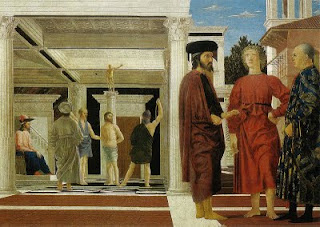I originally felt like trying a profile after looking at renaissance profiles, not only Piero's famous Federico da Montefeltro and Battista Sforza, but also paintings by Pollaiolo and Piero di Cosimo.
Recently a drawing of a girl in profile was attributed to Leonardo by analyzing a fingerprint found on the paper. It doesn't seem a Leonardo to me but definitely the image has stuck to my memory.
So why the profile? My first thought is that painting a profile switches the attention away from the personality of the sitter, and denies the viewer the psychological reading that many people look for. The model is looking away and the viewer is not compelled to look at her in the eyes. The attention is shifted to the model's features and to the composition of the painting.
This portrait of Clelia was painted in two sittings. I had done a first attempt during a previous sitting but I didn't find it interesting and have now destroyed it. This second one is more carefully planned and designed.
What I tried to do was incorporate a rigorous geometric construction underneath the painting. I think it gives the portrait a calm elegance and a strong balance.
Here are the lines I have used to establish the placement of the head and shoulders. You have to take my word that despite the straightening and idealizing of some lines the resemblance with the model is still there !
The landscape format allows for more space behind and in front of her, some space to breathe.
The axis of the composition is the diagonal from the top left corner to the bottom right, that passes through her cheekbone. I then considered the two lines that form an x on the right of the painting: they both go from the corner to the middle of the length. Both sides of her shirt align with one of these lines, while her back and her hairline align with the other.
The back of her neck is completely vertical and she is placed as in a pyramid, with her forehead parallel to the line on the left. The overall design is made more gentle by a series of curves: her throat, her right shoulder and the hairdo.
The second profile is also painted with an awareness of geometry, but the paint application is allowed more freedom. It was done over one sitting on a small board.

The tip of her nose is placed halfway down the height, while again the axis of the composition is the top left to bottom right diagonal, to which the hair is parallel. The horizontal line that divides the part of the hair which is lit ( grey) from the part directly facing me ( black) is placed at a third of the height.
I have tried, while painting, to make the back of the head turn on the horizontal line on the middle but it just didn't look right anatomically.
Anyway I am satisfied with both works and I hope this post might offer a different and interesting way to look at a painting.


















